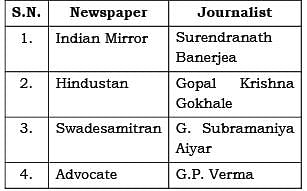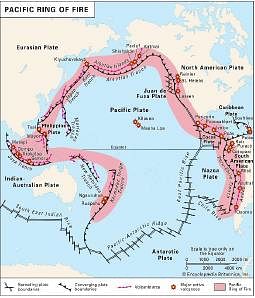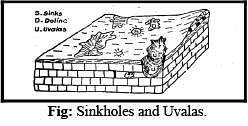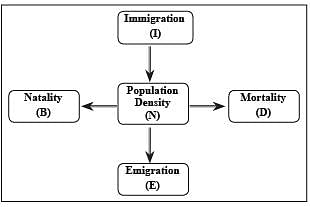UPSC CSE Complete Practice Test - 9 - UPSC MCQ
30 Questions MCQ Test - UPSC CSE Complete Practice Test - 9
With reference to the conditions for the development of Karst topography, consider the following statements:
1. The region should consist of limestone bedrock formation.
2. The soluble rock should be highly jointed and in thin beds.
3. Trenched major valleys should have soluble and well-jointed bedrocks.
How many of the above statements are correct?
1. The region should consist of limestone bedrock formation.
2. The soluble rock should be highly jointed and in thin beds.
3. Trenched major valleys should have soluble and well-jointed bedrocks.
Which of the following plates are located along the Pacific Ring of Fire region?
1. Nazca
2. Cocos
3. Anatolian
4. Juan de Fuca
Select the correct answer using the code given below:
1. Nazca
2. Cocos
3. Anatolian
4. Juan de Fuca
| 1 Crore+ students have signed up on EduRev. Have you? Download the App |
Consider the following statements regarding Current account deficit (CAD).
- When the value of the goods and services that a country exports exceeds the value of the products it imports, it is known as the current account deficit.
- If the current account shows a surplus, that indicates money is flowing into the country and boosting the foreign exchange reserves.
- Inflow of Remittances are not considered while calculating Current account deficit.
How many of the above statements are correct?
Consider the following:
1. Madras was the fi rst state to be renamed, after Independence.
2. The names of the States can be changes as per the provision under States Reorganisation Act, 1956.
3. Parliament has power to change name of state even if such proposal has been rejected by the State legislature.
How many of the statements given above are incorrect?
The doctrine of promissory estoppel was developed within the ambit of which one of the following?
Consider the following statements regarding the Indian Regional Navigation Satellite System (IRNSS):
- The IRNSS space segment consists of 10 satellites.
- IRNSS can provide accurate position information service in India as well as regions extending up to 1500 km around India.
- It provides a navigation solution with position accuracy better than 20 m during all weather conditions anywhere within India.
How many of the statements given above are correct?
Consider the following Statements:
- Money Multiplier is the fraction of the total deposits which commercial banks keep as reserves,
- Currency deposit Ratio is the ratio of deposits of public in bank to currency held by Bank.
- Reserve Deposit Ratio is the sum of SLR and CRR.
- Money Multiplier increases when RBI adopts ‘dovish’ monetary policy to combat deflation.
How many of the above statement(s) is/are correct?
Consider the following statements regarding Indian Ocean Dipole (IOD).
- The IOD is an ocean-atmosphere interaction very similar to the El Nino fluctuations in the Pacific Ocean.
- It is always a much stronger system than El Nino, and thus has relatively greater impacts.
- A positive IOD have the potential to offset the impacts of El Nino to a small measure in neighbouring areas.
How many of the above statements are correct?
With reference to the modern Indian history, consider the following pairs:

How many of the above pairs is/are correctly matched?
Chauchala’ and ‘Dochala’ are the styles of architecture associated with which of the following?
Consider the following statements about “Deficit” in the Annual Financial Statement:
- Effective Revenue Defi cit signifi es that amount of capital receipts that are being used for actual consumption expenditure of the government.
- A shrinking primary defi cit indicates progress towards fiscal health.
- Fiscal Deficit equals the money which government needs to borrow during the year.
Which of the statements given above is/are incorrect?
Consider the following provisions under PESA Act:
1. Gram sabha at the para, majra and tola levels
2. Gram sabha to protect the traditions, beliefs and culture of the tribal communities
3. Gram sabha to manage and protect common properties based on their traditional systems of management and protection
4. The administration to seek permission from the gram sabha in case of land acquisition
Select the correct answer using the codes given below.
Consider the following:
1. The entire world is animated.
2. Monastic existence is a necessary condition of salvation.
3. Karma shapes the cycle of birth and rebirth.
How many of the above are basic tenets of Jainism ?
Consider the following statements with reference to Lumpy Skin Diseases:
1. It is a viral disease that affects cattle.
2. It can be transmitted by sanguinivorous insects.
3. No vaccination is available for its treatment.
How many of the statements given above are correct?
Consider the following statements:
1. If arrested, the person has the right to defend himself by a lawyer of his choice.
2. It is mandatory for the police to take that person to the nearest magistrate within 48 hours.
3. The magistrate will decide whether the arrest is justifi ed or not.
4. The Supreme Court has ruled that right to life and personal liberty includes right to live with human dignity, free from exploitation.
Which of the above statements is/are correct?
Consider the following statements:
1. In early 1950s, States of India were divided into three Parts and their heads were namely, the Governor, Rajpramukhs and Chief Commissioners.
2. The former princely states or group of princely states were governed separately by the Central government.
Which of the statements given above is/are correct?
Regarding the sources of revenues of Urban Local Bodies (ULBs), consider the following:
1. Collection from tax and non-tax sources as assigned to them under Municipal act.
2. Devolution of shared taxes and duties as per recommendation of State Finance Commission
3. Grants-in-aid from the State Government
4. Grants-in-aid from the Government of India under Centrally Sponsored Schemes
Select the correct answer using the codes given below.
In the context of constitution, consider the following statements:
1. It provides a set of basic rules that allow for minimal coordination amongst members of a society.
2. It specifi es who has the power to make decisions in a society.
3. The constitution does not set the limit on what a government can impose on its citizens.
4. It enables the government to fulfi l the aspirations of a society and create conditions for a just society.
How many of the above statements are correct?
The ‘Business Ready (B-READY) project’ is an initiative of which one of the following organisations?
With reference to the Indian National Movement, consider the following statements:
- The All-India Muslim League was founded in 1906, under the leadership of Aga Khan and Nawab Mohsin – ul – Mulk.
- The Muslim League opposed the partition of Bengal made by Lord Curzon.
- At the Lucknow session of 1916, the Indian National Congress accepted the demand of separate electorates by the Muslim League.
How many of the above statements is/are correct?
With reference to the Vernacular Press Act of 1878, consider the following statements:
- Press equipment of the vernacular newspapers could be seized in case they contravened the provisions of the Act at the first instance.
- As per the Act, an appeal could be made against the magistrate's action in a court of law.
- This Act provided for no exemptions to the vernacular newspapers.
How many of the above statements is/are incorrect?
‘Sinkholes may expand in diameter and as a result, they unite to form a compound sinkhole. Sometimes these may be developed from the surface to join the passage already made. This leads to the collapse of a certain part of the roof resulting in the formation of large depressions.Which of the following terms best describes the passage given above?
Consider the following statements:
1. Every person who is a member of All India Service holds offic e during the pleasure of the President
2. If a government employee is convicted in a criminal case, he can be dismissed without Departmental Enquiry.
Which of the statements given above is/are correct?
The terms 'isoniazid', 'rifampin', 'ethambutol' are often seen in the news. What are they?
Consider the following countries:
- United States
- Canada
- Germany
- Japan
- India
How many of the above are the members of the Group of Seven (G7) Countries?
Match the following pairs:
1. Natality - It refers to the number of births during a given period in the population that are added to the initial density.
2. Mortality - It is the number of deaths in the population during a given period.
3. Immigration - It is the number of individuals of the same species that have come into the habitat from elsewhere during the time period under consideration.
4. Emigration - It is the number of individuals of the population who left the habitat and gone elsewhere during the time period under consideration.
How many of the above pairs is/are correctly matched?
Consider the following statements:
Statement I: In India, cervical cancer is the most common cancer in women.
Statement II: To prevent rising incidence of cervical cancer, India has introduced Human Papillomavirus (HPV) Vaccine in the Universal Immunization Programme (UIP).
Which one of the following is correct in respect of the above statements?
The 'Bletchley Declaration', sometimes seen in the news, is related to
Consider the following statements:
- Leopard (Panthera pardus) is listed as Vulnerable on the IUCN Red List.
- In India,Madhya Pradesh has the highest number of leopards followed by Maharashtra.
- It is nocturnal and preys on smaller herbivores like chital and wild boa.
How many of the given above statement(s) is/are correct?
Consider the following statements:
- A ramjet is a form of air-breathing jet engine that uses the vehicle’s forward motion to compress incoming air for combustion.
- A scramjet is a type of ramjet airbreathing jet engine where combustion occurs in supersonic airflow.
- Ramjets work most efficiently at hypersonic speeds.
How many of the statements given above are correct?




















